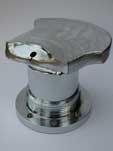| Crankshaft Failure
In 1990 I made a long journey, aiming
to attend a meeting in Coventry. Whilst caught in traffic
on a motorway I noticed an uneven idle, but the car seemed
to rev fine and the uneveness wasnt noticeable above 1200
rpm. After about another 1.5 Hours of high speed motoring
(whilst I was overtaking a truck at ~85 mph) something big
gave way! As I stopped, the engine was still idling but making
an enormous mechanical bang once a revolution. This required
a tow home and further investigation. I initially assumed
a big end cap had come away, but there were no holes in the
block, and apart from the noise, the engine appearedf to be
running on 4 cylinders. Removing the sump, expecting to be
greeted by obvious signs of damage, I was surprised to find
nothing appearing to be wrong. Only when turning the engine
by hand could I see the crank had split between No4 Big End
bearing and the final Main Bearing--so the pistons weren't
physically connected to the flywheel any more! Crank
failures are known on the TR's 4 cyl engine, and this is normally
blamed upon resonance in the crank around 3000 rpm (I certainly
spent many hours cruising at 3200 rpm, which equated to 75mph,
on motorways). People often state that removing the original
fan assemby excacerbates this problem, as the fan provides
some damping action for the crank. This may be so, but my
car has always had the original fan fitted (as far as know)
so a more likely cause is failed propshaft UJ's (see elsehwere).
A spare crank was obtained (thanks Max!) and fitted during
a full rebuild of the bottom end.
 |
The exact form of the fracture
was from the inner edge of No4 big end (initiated by the
sharp angle between the web of the crank and the bearing
surface). The surface shows the slow progression of the
crack, followed by final brittle fracture. I guess it
was cracked part-way when I noted the uneven idle.
The end of the crank (No3 Main Bearing, Flywheel flange
and that's all) is now a chrome plated objet d'art...
|
As an aside, when
I initially guessed that a big end cap giving way was the
cause of the problem, a friend and I decided that since the
engine was most probably entirely wrecked, starting it would
cause no further damage....Therefore, in order to get the
car into a suitable place to strip out the sump, we decided
to drive it up a steep slope into a garage. It drove surprisingly
well (in hindsight), OK there was a lot of noise, but the
car pulled up the slope fine, with no evidence of slipping
drive in any way. I now guess that the 2 sections of the crank
must have been in contact with one another to transmit drive.
|


